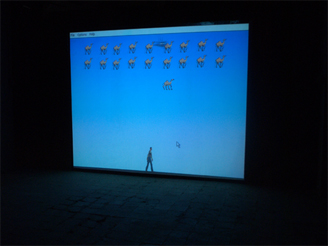
Entering the world of online glitch art can feel like stepping into your worst computer nightmare. Error messages, garbled code and corrupted images are a pervading aesthetic. Sometimes turning technology inside out, sometimes capturing moments of technological breakdown, sometimes translating the non-technological into technology, glitch simultaneously exposes and embraces the digital fabric that makes up more and more of our world, treating the bits and pixels and symbols of the web and computers like clay or paint ― and the failures of those bits and pixels as the highest expression of beauty.
“It’s not so much a movement as a mode of working,” says Ania Szremski, programming director at the Townhouse Gallery, where “d1sc0nN3ct,” a week-long exhibition of glitch work by artists from Cairo and Alexandria, opened on Sunday evening at the factory space.
Glitch is most comfortable existing online, where the interaction between the work and the viewer is intimate and direct ― one human and one computer screen. But another side of the appeal of the online space is freedom from the implications of commodity endowed on objects displayed at art galleries.
“Part of the ideology of this mode is very anti-capitalist. It is about breaking objects that can be sold,” adds Szremski.
For most of the pieces in “d1sc0nN3ct,” the artists never intended their work to leave the digital space, and in putting together the exhibition, engaged in extended collaboration with Szremski over the appropriate means to turn digital files into objects for display in the physical world.
In “Perfect Reality,” Alexandria-based artist Sarah Samy presents three captures from Google Street View in which Google’s software has left an error in the scene: a disembodied head, a blank space. The images are displayed in three small light boxes. The effect is something between a hanging photograph and an image on a screen. The images, only a few samples of nearly 50 that Samy has collected, are separated from the digital world that generated them, but they nonetheless maintain shades of their digital past. The presentation lifts up these small, beautiful moments of failure to a position of significance both as images and as events, highlighting their strangely poetic elegance.
Within the community of artists working in glitch, there are ongoing debates about what exactly can be categorized as such. A basic tenet is that the work must in some way discover, create or otherwise revolve around errors in technology. Ahmed al-Shaer’s art video game, “Nekh,” a program Shaer wrote and designed himself, does not quite fit the orthodox method. But the video game’s absurdist looping captures the spirit of playful confusion present in much glitch work. The program, whose name means “on your knees,” is made in the style of early computer games in which an object moving back and forth shoots at another flying above. In Shaer’s game, it takes some time to realize that attempts at shooting just bring you closer and closer to your own demise ― and then you start all over again.
Kareem Lotfy’s untitled work, a large wall projection of a series of shimmering, patterned GIFs, approaches the creation of digital images with a sense for the sensuous potential of pixels. His images are digital recreations of moire fabric, a specially woven textile that maintains a watery, ever-shifting texture. As with Samy’s work, presentation in the gallery has given the piece a new layer of expression and meaning, perhaps not an improvement on the original, internet-confined work, but a valuable new iteration. Szremski explained that while the plan for installation initially centered on maintaining the intimate interaction of the internet, it eventually evolved into an evocation of a “digital tapestry,” embracing the opportunity to present something with monumental scale.
While “d1sc0nN3ct” presents the work of a group of Egyptian artists engaging in glitch work, it is not meant to show “Egyptian” glitch. In fact, in its very nature glitch is deeply international, existing in a space that is as free of national borders as it is of gallery walls.
“Kareem [Lotfy] and Sarah [Samy] told me that they want to be completely international ― and this is part of their taking on glitch work,” says Szremski, citing her early talks with the artists. This appears uniquely possible when working in a digital mode. The work is so new and so free of geography, and artists from across the world are able to collaborate and share ideas.
And while galleries in Cairo often seek to present “young artists,” this is rarely expressed through an engagement with a new way of working, which is part of what is exciting about “d1sc0nN3ct.” This new way is exciting in its own right, for its playfulness, its cheekiness, and the new and constantly changing relationships it creates between artists, viewers and technology.
“d1sc0nN3ct” was first envisioned as a week-long festival with nightly events. Due to postponement and political events of recent weeks, a number of the events have been canceled, but there will be a screening of work by international glitch artists on Tuesday night at 7 pm, and a Skype-in talk by glitch artist and theorist Nick Briz on Thursday at 7 pm at the Townhouse library.
The exhibition will be open through Saturday, 10 December, from 10 am to 2 pm and 6 pm to 9 pm at the Townhouse Gallery, 10 Nabrawy St., Downtown Cairo.




